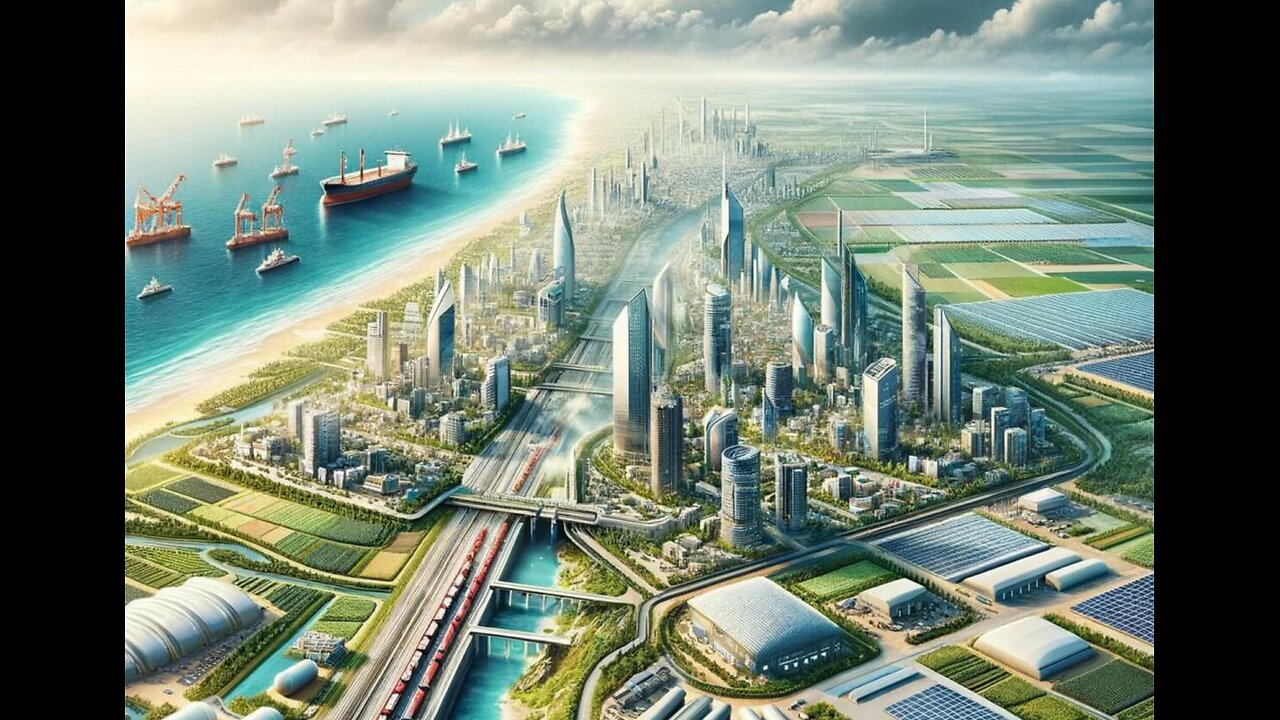Premium Only Content

Netenyahu’s 2035 GAZA Land Grab Concept + Links
Israel Prime Minister Benjamin Netanyahu’s office recently released a PowerPoint that gives a glimpse into what the Likud Party has in mind for Gaza’s future, and the Levant region at large. On May 3, Netanyahu unveiled Gaza 2035: A three-step master plan to build what he calls the “Gaza-Arish-Sderot Free Trade Zone.” The plan was first reported by The Jerusalem Post and later by Al Jazeera.
The Gaza-Arish-Sderot Free Trade Zone would encompass the 141 square miles that make up the Gaza Strip, where more than 34,500 Palestinians have been killed by Israeli forces in the past several months, and where experts say that famine is underway. The zone also would include the El-Arish Port to Gaza’s south in Egypt’s Sinai Peninsula and Sderot, an Israeli city north of Gaza.
UN officials issued a report on May 2 stating that over 70 percent of Gaza’s building stock has been destroyed, and that it would cost $40–50 billion to rebuild. This prompted one UN official, Abdallah al-Dardari, to say: “We have not seen anything like this since 1945.”
Under the auspices of Gaza 2035, the new free trade zone would be administered by Israel, Egypt, and what the Israeli Prime Minister calls the Gaza Rehabilitation Authority (GRA)—a proposed Palestinian-run agency that would oversee reconstruction in Gaza and “manage the Strip’s finances.”
The PowerPoint affirms that the GRA would not deliver Palestinian statehood and makes no reference to a two-state system. Instead, by 2035, Gaza and the West Bank would be placed under the “nominal administration” of the Palestinian Authority (PA) and Israel would be responsible for the free trade zone’s security. yNet correspondent Ron Ben Yishai called Gaza 2035 Benjamin Netanyahu’s “Singapore vision.”
Gaza 2035 is officially entitled Plan for the Transformation of the Gaza Strip and it promises to deliver Gaza “from crisis to prosperity.” Netanyahu’s idea entails “rebuilding from nothing,” he said.
The regional plan has been met with opposition. On May 16, UAE Foreign Minister Sheikh Abdullah bin Zayed Al Nahyan condemned the plan in in a public statement. Lara Elborno, a Palestinian-American human rights lawyer, said on social media: “Israel’s plan to steal our gas and subject us to this dystopian future must be unequivocally opposed with urgency. Gaza is not ‘nothing.’”
Netanyahu’s “Marshall Plan”
If Netanyahu’s “Marshall Plan” is successful, the PM said, it can be “repeated in Yemen, Syria, and Lebanon.” Gaza 2035 comes less than one year after Netanyahu presented his “Greater Israel” plan at the UN, which posited the West Bank, Gaza, and East Jerusalem’s absorption into the state of Israel’s official boundaries.
Overall, Gaza 2035 would happen in three distinct stages. The first stage, entitled “Humanitarian Aid,” consists of a 12-month program that would “deradicalise” Gaza and eradicate Hamas. The second stage would last between 5 to 10 years, during which Saudi Arabia, UAE, Egypt, Bahrain, Jordan, and Morocco would “supervise” Gaza’s reconstruction. The final stage would be when Palestine signs the Abraham Accords signaling “Palestinian self-rule,” albeit without statehood.
Of the Arab countries mentioned, the UAE is the only to have commented on the plan. UAE Foreign Minister Sheikh Abdullah bin Zayed Al Nahyan said: “United Arab Emirates denounces statements by Israeli Prime Minister, Benjamin Netanyahu, calling on the [UAE] to participate in the civil administration of the Gaza Strip, which is under Israeli occupation.” The statement continued that “the UAE stresses that the Israeli Prime Minister does not have the legal capacity to take this step, and the state refuses to be drawn into any plan aimed at providing cover for Israeli presence in the Gaza Strip.”
Connecting Gaza to NEOM?
Renderings in the Gaza 2035 document, created with AI, show futuristic skyscrapers, solar fields, and water desalination plants in the Sinai Peninsula, a new high speed rail corridor along Salah al-Din Road (Gaza’s main highway that connects Gaza City and Rafah), and oil rigs off of Gaza’s shoreline.
The oil rigs and container ships aren’t superfluous: In 2019, UN analysts estimated that more than 3.2 billion barrels of oil sit beneath Gaza’s port area and the West Bank estimated at billions of dollars in value. According to the UN, the Mediterranean Sea’s Levant Basin may possess 1.7 billion barrels, and the West Bank may have 1.5 billion barrels. These findings prompted environmental journalist Yessenia Funes, writing in Atmos (and quoting Shereen Talaat, founder and director of MENAFem Movement for Economic, Development, and Ecological Justice) to describe Israel’s 2023–24 military actions in Gaza as motivated by resources: “This genocide is about oil,” Funes said.
Gaza 2035 is officially entitled Plan for the Transformation of the Gaza Strip and it promises to deliver Gaza “from crisis to prosperity.” Netanyahu’s idea entails “rebuilding from nothing,” he said.
The regional plan has been met with opposition. On May 16, UAE Foreign Minister Sheikh Abdullah bin Zayed Al Nahyan condemned the plan in in a public statement. Lara Elborno, a Palestinian-American human rights lawyer, said on social media: “Israel’s plan to steal our gas and subject us to this dystopian future must be unequivocally opposed with urgency. Gaza is not ‘nothing.’”
Netanyahu’s “Marshall Plan”
If Netanyahu’s “Marshall Plan” is successful, the PM said, it can be “repeated in Yemen, Syria, and Lebanon.” Gaza 2035 comes less than one year after Netanyahu presented his “Greater Israel” plan at the UN, which posited the West Bank, Gaza, and East Jerusalem’s absorption into the state of Israel’s official boundaries.
Overall, Gaza 2035 would happen in three distinct stages. The first stage, entitled “Humanitarian Aid,” consists of a 12-month program that would “deradicalise” Gaza and eradicate Hamas. The second stage would last between 5 to 10 years, during which Saudi Arabia, UAE, Egypt, Bahrain, Jordan, and Morocco would “supervise” Gaza’s reconstruction. The final stage would be when Palestine signs the Abraham Accords signaling “Palestinian self-rule,” albeit without statehood.
Of the Arab countries mentioned, the UAE is the only to have commented on the plan. UAE Foreign Minister Sheikh Abdullah bin Zayed Al Nahyan said: “United Arab Emirates denounces statements by Israeli Prime Minister, Benjamin Netanyahu, calling on the [UAE] to participate in the civil administration of the Gaza Strip, which is under Israeli occupation.” The statement continued that “the UAE stresses that the Israeli Prime Minister does not have the legal capacity to take this step, and the state refuses to be drawn into any plan aimed at providing cover for Israeli presence in the Gaza Strip.”
Connecting Gaza to NEOM?
Renderings in the Gaza 2035 document, created with AI, show futuristic skyscrapers, solar fields, and water desalination plants in the Sinai Peninsula, a new high speed rail corridor along Salah al-Din Road (Gaza’s main highway that connects Gaza City and Rafah), and oil rigs off of Gaza’s shoreline.
The oil rigs and container ships aren’t superfluous: In 2019, UN analysts estimated that more than 3.2 billion barrels of oil sit beneath Gaza’s port area and the West Bank estimated at billions of dollars in value. According to the UN, the Mediterranean Sea’s Levant Basin may possess 1.7 billion barrels, and the West Bank may have 1.5 billion barrels. These findings prompted environmental journalist Yessenia Funes, writing in Atmos (and quoting Shereen Talaat, founder and director of MENAFem Movement for Economic, Development, and Ecological Justice) to describe Israel’s 2023–24 military actions in Gaza as motivated by resources: “This genocide is about oil,” Funes said.
Beyond the AI-generated renderings, the diagrams are also important. Today, Gaza is at the nexus of a historic trade route in the Middle East between Cairo and Baghdad, and Europe and Yemen. Gaza 2035 would capitalize upon this geography by adding new east-west rail service between Alexandria, Egypt, and Gaza City, Palestine. It would also add north-south rail service between Gaza and NEOM—the speculative $500 billion Saudi city roughly 130 miles south of Rafah. All of this connectivity would open up the opportunity for tech companies, factories, and “electric-vehicle manufacturing cities” to migrate to the Gaza-Arish-Sderot Free Trade Zone, the document said.
Israel Railway currently has 66 stations; its service terminates to the south in Dimona. Under Gaza 2035, the new Gaza-NEOM line would extend service about 100 miles from Dimona to Aqaba, Jordan, and then connect to NEOM. The Gaza-NEOM line would have a stop in Be’er Shiva, Israel, and then split at a junction near Sderot, either sending trains to Rafah or Tel Aviv – Haifa
The proposal for a new Gaza-NEOM railway fits into Saudi Arabia’s Vision 2030 which seeks to normalize relations with Israel partially by constructing the speculative city, which has since been scaled back from 170 kilometers to 2.5 kilometers in length.
In northern Gaza, there would also be a new “electric vehicle manufacturing city.” In the south, there would be new railroads between Gaza and the Sinai Peninsula’s El-Arish Marine Port and El-Gora Airport, a small regional hub twelve miles south of Rafah. This would link with the India-Middle East-Europe-Economic Corridor (IMEC), a Silk Road initiative to connect Asia and Europe.
“Gaza’s waterfront could be very valuable”
-
 1:59:43
1:59:43
Side Scrollers Podcast
2 days agoRIP Hulk Hogan + Payment Processor CENSORSHIP Has Officially Begun + More | Side Scrollers
3.1K7 -
 12:14
12:14
Nikko Ortiz
1 day agoMilitary Fails Of The Week
2.3K5 -
 1:16:31
1:16:31
Omar Elattar
9 months agoThe Untold Story: How Vans Became a $3 Billion Dollar Shoe Empire In 75 mins
200 -
 LIVE
LIVE
Lofi Girl
2 years agoSynthwave Radio 🌌 - beats to chill/game to
230 watching -
 1:56:31
1:56:31
The Pascal Show
14 hours ago $0.17 earnedGHISLAINE FLIPS?! DOJ Receives SECRET LIST of 100 Epstein Associates!”
1821 -
 10:17
10:17
Dr Disrespect
11 days agoIt's Time To Get Serious
174K27 -
 2:15:09
2:15:09
Badlands Media
21 hours agoDevolution Power Hour Ep. 375: Obama’s Orders, Ukraine’s Collapse & the Inversion of Justice
251K66 -
 2:32:03
2:32:03
BlackDiamondGunsandGear
11 hours agoAFTER HOURS ARMORY w/ DLD & John from GOA & FLR
20.4K3 -
 1:05:28
1:05:28
Man in America
12 hours agoTREASON? Obama, Hillary, and Soros in the New World Order Agenda EXPOSED w/ Mel K
76.1K57 -
 2:22:46
2:22:46
The Connect: With Johnny Mitchell
12 hours ago $3.54 earnedOne Man's Mission To Stop Human Trafficking: How A Billionaire Mercenary Saved Hundreds Of Children
17.7K11